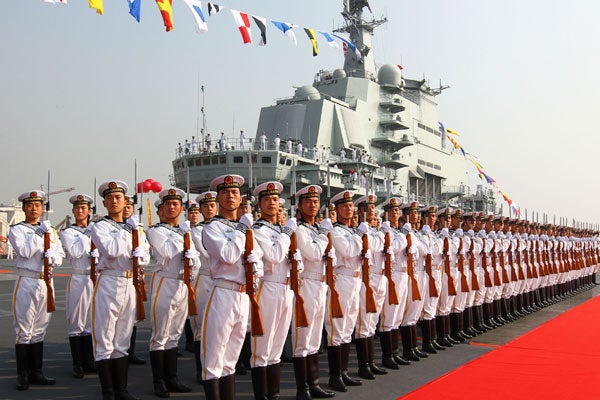Pentagon Report on China Reveals Comprehensive Military Buildup, Extensive Espionage
Dean Cheng /
The Department of Defense (DOD), per the requirements of the fiscal year 2000 National Defense Authorization Act (NDAA), this week issued the 2013 annual report to Congress on the Chinese military. This year’s report is a substantial expansion upon the 2012 report, nearly double in length, and with an extensive discussion of a number of areas. In addition to reading the valuable information in its pages, Washington should be reminded just how absolutely necessary this report is.
The most obvious takeaway is that the People’s Liberation Army (PLA) is engaged in a massive, extensive modernization program, drawing upon the resources of a constantly expanding economy (now the world’s second largest) to support improvements in not only the ground forces, but the PLA Navy (PLAN), the PLA Air Force (PLAAF), the Second Artillery (China’s rocket forces), as well as space and cyber capabilities.
The report provides details of various new ship classes, new fighters, new missiles, and improvements in Chinese space assets. Far from having to choose between guns or butter, the PLA is, in the words of my economics counterpart Derek Scissors, “buying guns soaked in butter.”
Even more important, this year’s report specifically charges the People’s Republic of China (PRC) and the PLA with engaging in cyber actions directed against the United States. “China is using its computer network exploitation (CNE) capability to support intelligence collection against the US diplomatic, economic, and defense industrial base sectors,” the report says.
While such concerns have been raised in many quarters, this is the first time that the DOD report has been so straightforward. As important, it reinforces the results of the Mandiant report and the Verizon Risk report of the past several months, both issued by private companies. These reports also highlighted the role of Chinese government and military assets in cyber-espionage activities.
Another aspect of China’s military that can be discerned in this year’s DOD report is the importance of space warfare. This is not only reflected in the specific sections of the report that discuss China’s military space activities, but also in the backgrounds provided for the top Chinese military leadership.
Central Military Commission (CMC) Vice Chairman Xu Qiliang, for example, is a PLAAF officer who has advocated that the PLAAF “should lead the development of offensive capabilities.” He attained this position after stating (and then retracting) that “the militarization of space was a ‘historical inevitability.’” The other CMC Vice Chairman, Fan Changlong, has extensive experience testing joint operations concepts, which rely on space-based assets for command, control, and coordination. Defense Minister Chang Wanquan was formerly head of the General Armaments Department (GAD), which oversees China’s weapons development and space complexes. The current head of the GAD, meanwhile, General Zhang Youxia, is one of the last Chinese military officers to have had combat experience, gained in the 1979 war with Vietnam. This suggests that alongside cyber, space capabilities will be a priority for the CMC and therefore the PLA.
Finally, there is an odd juxtaposition in this year’s report. On the one hand, there is extensive discussion of Chinese military diplomacy, including the range of Chinese bilateral and multilateral military exercises, as well as military-to-military exchanges, visits, etc. This is alongside a remarkably detailed review of Chinese espionage, both human and cyber. A number of Chinese spies are identified, as well as their targets.
What is left unstated is why the U.S. intends, in light of the concerns about espionage, to facilitate Chinese military diplomacy, such as the invitation to the PLA to attend the 2014 Rim of the Pacific (RIMPAC) exercises. These large, multilateral exercises, involving many of America’s closest allies in the Pacific engaging in real-world combat training (e.g., torpedo attacks, air defense operations) would seem to be a cornucopia of information for Chinese intelligence.
Inviting the Chinese to attend would seem to play into Beijing’s efforts to expand their military diplomatic sphere. Why would the U.S. want to give the Chinese an opportunity to both expand influence and garner important information, not only from ourselves, but from our allies?
All of these aspects serve as a reminder that this annual report is an enormously helpful, authoritative source of information on the Chinese military. For precisely this reason, calling for its abolition has long been a standing official Chinese talking point. This year’s report is no different. This Administration, enamored as it is of the power of “engagement,” and Congress must resist all efforts to abolish or water down the requirement.

